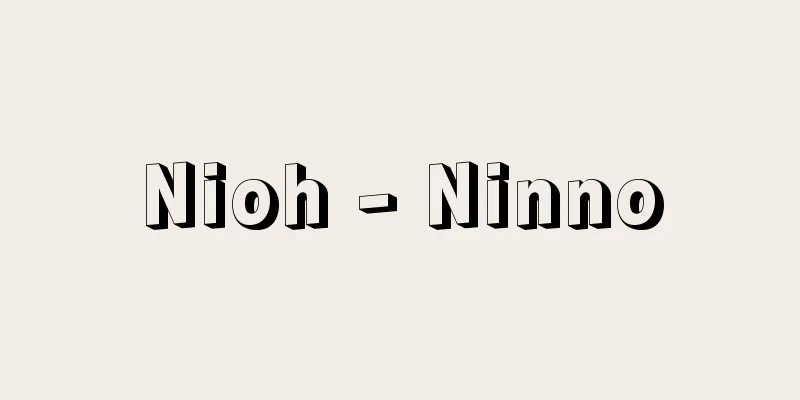Tokyo National Museum

|
Japan's oldest and largest art museum. It is located in Ueno Park, Taito Ward, Tokyo. It began in September 1872 (Meiji 5) when the Taiseido Hall in Kanda Yushima was converted into a museum. In 1881, it moved to its current location (the former site of the Kan'ei-ji temple main hall) and opened a new museum designed by British architect Conder. In 1908 (Meiji 41), the Hyokeikan (designated an Important Cultural Property; 2,049 square meters) designed by Katayama Tokuma was completed, and in 1938 (Showa 13), the current main building (revised from the winning design in a design competition by a committee including Ito Chuta; 22,416 square meters) opened in place of the old main building, which was damaged in the Great Kanto Earthquake in 1923 (Taisho 12). These two buildings survived damage during World War II and remain in their current state. During this time, the museum passed from the jurisdiction of the Ministry of Agriculture and Commerce to the Imperial Museum and then to the Imperial Household Museum. After the war, in 1947 (Showa 22), with the promulgation of the new constitution, it was renamed the National Museum. Furthermore, with the enactment of the Law for the Protection of Cultural Properties in 1950, it became an affiliated institution of the Law's Protection Committee and was renamed the Tokyo National Museum. It then came under the jurisdiction of the Agency for Cultural Affairs when it was established in 1968. In April 2001, it became the National Museum, an Independent Administrative Institution, and in April 2007, it became an organization within the National Institutes for Cultural Heritage, an Independent Administrative Institution. In terms of facilities, the Gallery of Horyu-ji Treasures (1,697 square meters) was completed in 1964, and the Toyokan (12,531 square meters) designed by Taniguchi Yoshiro was completed in 1968, expanding the existing two buildings to a vast scale. The Gallery of Horyu-ji Treasures was renovated (3,980 square meters) and opened in July 1999 (Heisei 11). In addition to these facilities, the 102,623 square meter grounds contain the Kuromon Gate of the former Ikeda residence, the Azekura storehouse of the former Jurin-in Temple treasure house, the Rokusoan teahouse built by Kanamori Sowa during the Keian era (1648-1652), as well as the remains of other historic buildings such as the Okyokan and Kujokan. The museum's stored exhibits mainly consist of art, crafts, and archaeological materials from Japan and other parts of Asia, totaling 116,268 items, of which 87 are national treasures and 634 are important cultural properties (as of the end of March 2015), in addition to 3,064 items on loan from outside the museum. The main work of the museum is collecting, storing and displaying these items, as well as conducting research and document collection. In February 1984, a new museum building was completed, allowing the museum to focus even more on these areas. In addition, the Heiseikan (17,981 square meters) was opened in October 1999 as a special exhibition space for planned exhibitions. In addition to regular displays (which are changed periodically in each department), the museum also holds special domestic and international exhibitions that are open to the public. Public outreach activities include providing explanations of the items on display, hosting lectures and courses, publishing the information magazine "National Museum News" and the magazine " Museum " (both bimonthly), issuing catalogs, creating films and slides, and holding traveling exhibitions around the country. The museum is closed every Monday (or the following day if Monday is a public holiday) and during the New Year holidays. [Shinichi Nagai January 19, 2017] "Tokyo National Museum supervised: Art Museums of the World 12 & 13: Tokyo National Museum I & II" (1966, 1967, Kodansha)" ▽ "Tokyo National Museum edited and published: History of the Tokyo National Museum over 100 years" (1973) ▽ "Tokyo National Museum edited: History of the Tokyo National Museum over 100 years: Documents" (1973, Daiichi Hoki Publishing) ▽ "Kitamura Tetsuro edited: Japanese Museums 1: The Tradition of Japanese Beauty - The Three Major National Museums" (1982, Kodansha) ▽ "Shinchosha edited and published: The Tokyo National Museum is So Fascinating" (1991) ▽ "Tokyo National Museum edited: Tokyo National Museum Guide/Main Building Edition: A Closer Look at Japanese Art" (1995, Tokyo Bijutsu)" ▽ "Weekly Asahi Encyclopedia: Japan's National Treasures 41, 42, 44-47" (1997, 1998, Asahi Shimbun) ▽ "Weekly World Art Museums 86: Tokyo National Museum" (2001, Kodansha) ▽ "Museum" edited by the Tokyo National Museum, published bimonthly (Otsuka Kogeisha)" ▽ "Tokyo National Museum Bulletin, edited and published by the Tokyo National Museum, various annual editions" [References] | | | | | | |The current main building opened in 1938 (Showa 13) in place of the old main building. It is an oriental-style building with a concrete structure and a tiled roof, and exhibits Japanese art, crafts, and historical materials. Nationally designated important cultural property Taito-ku, Tokyo ©Yutaka Sakano "> Tokyo National Museum A museum designed by Conder (the former main building of the Tokyo National Museum) that was located in Ueno Park, Shita-ya Ward (currently Ueno Park, Taito Ward, Tokyo). It became the Imperial Museum in 1889 (Meiji 22) and the Tokyo Imperial Household Museum in 1900. "Latest Tokyo Famous Places Photograph Album" (1909 (Meiji 42)) National Diet Library Collection "> Tokyo Imperial Household Museum It is still located on the grounds of the Tokyo National Museum and is used as an exhibition hall. Ueno Park, Shita-ya Ward (currently Ueno Park, Taito Ward, Tokyo). It was designated an Important Cultural Property of Japan in 1978 (Showa 53). "Tokyo Landscape" (1911 (Meiji 44)) National Diet Library Collection "> Hyokeikan (Meiji period) Source: Shogakukan Encyclopedia Nipponica About Encyclopedia Nipponica Information | Legend |
|
日本最古・最大の美術博物館。東京都台東(たいとう)区上野公園にある。1872年(明治5)9月、神田・湯島のもと聖堂大成殿を博物館にしたのがその初めで、1881年に現在地(旧、寛永寺本坊跡)に移転、イギリスの建築家コンドルの設計による新博物館が開館した。1908年(明治41)には片山東熊(とうくま)設計の表慶館(重要文化財指定。2049平方メートル)が竣工(しゅんこう)、また1923年(大正12)の関東大震災で罹災(りさい)した旧本館にかわって、1938年(昭和13)には現在の本館である新館(設計競技の当選作を伊東忠太(ちゅうた)らの委員が修正。2万2416平方メートル)が開館、この2館は第二次世界大戦の被害を免れ現在に至っている。この間、農商務省の所管から、帝国博物館、さらに帝室博物館と転じ、戦後は1947年(昭和22)新憲法公布とともに国立博物館と改称、さらに1950年の文化財保護法制定に伴い、同保護委員会の付属機関となって東京国立博物館と改称、ついで1968年の文化庁発足と同時にその所管となり、2001年(平成13)4月から独立行政法人国立博物館、2007年4月から独立行政法人国立文化財機構のなかの一つの組織となった。 施設の面でも1964年に法隆寺宝物館(1697平方メートル)、1968年には谷口吉郎(よしろう)設計の東洋館(1万2531平方メートル)が完成し、既存の2館とあわせて広大な規模に拡充された。法隆寺宝物館は改築され(3980平方メートル)、1999年(平成11)7月開館した。10万2623平方メートルに及ぶ敷地内にはこれらの施設のほか、旧池田屋敷の黒門、旧十輪院宝蔵の校倉(あぜくら)、慶安(けいあん)年間(1648~1652)に金森宗和(そうわ)がつくった茶室六窓庵(ろくそうあん)をはじめ、応挙館、九条館など由緒ある建築の遺構が移建されている。館内の保管陳列品は主として日本およびアジア諸地域の美術・工芸・考古資料などで、あわせて総数11万6268点、うち国宝87件、重要文化財634件(2015年3月末時点)で、ほかに外部からの出品寄託品も3064点に及んでいる。 博物館のおもな仕事は、これら収蔵品の収集・保管・展示のほか、調査・研究・資料収集などであるが、1984年2月には新しく資料館の建物が完成し、この方面の活動に一段と力を入れるようになった。また企画展のための特別展示場として平成館(1万7981平方メートル)が1999年(平成11)10月開館した。展示は平常陳列(各部門とも定期的に陳列替えが行われている)のほか、内外の特別展が催され、広く一般の観覧に供している。普及活動においても列品解説・講演・講座の開催、情報誌『国立博物館ニュース』、雑誌『Museum』(ともに隔月刊)、目録などの発行、映画・スライドの作成、地方巡回展など各種に及んでいる。 休館日は毎週月曜日(祝日の場合翌日)と、年末年始。 [永井信一 2017年1月19日] 『東京国立博物館監修『世界の美術館12・13 東京国立博物館Ⅰ・Ⅱ』(1966、1967・講談社)』▽『東京国立博物館編・刊『東京国立博物館百年史』(1973)』▽『東京国立博物館編『東京国立博物館百年史 資料編』(1973・第一法規出版)』▽『北村哲郎編『日本の博物館1 日本美の伝統――三大国立博物館』(1982・講談社)』▽『新潮社編・刊『こんなに面白い東京国立博物館』(1991)』▽『東京国立博物館編『東京国立博物館ガイド/本館編 一歩近づいて見る日本の美術』(1995・東京美術)』▽『『週刊朝日百科 日本の国宝41、42、44~47』(1997,1998・朝日新聞社)』▽『『週刊世界の美術館86 東京国立博物館』(2001・講談社)』▽『東京国立博物館編『Museum』隔月刊(大塚巧芸社)』▽『東京国立博物館編・刊『東京国立博物館紀要』各年版』 [参照項目] | | | | | | |旧本館にかわって1938年(昭和13)に開館した現在の本館。コンクリート建築に屋根瓦を葺いた東洋風の建物で、日本の美術、工芸、歴史資料を展示する。国指定重要文化財 東京都台東区©Yutaka Sakano"> 東京国立博物館 下谷区上野公園(現在の東京都台東区上野公園)にあったコンドル設計の博物館(東京国立博物館旧本館)。1889年(明治22)に帝国博物館、1900年に東京帝室博物館となった。『最新東京名所写真帖』(1909年〈明治42〉)国立国会図書館所蔵"> 東京帝室博物館 現在も東京国立博物館敷地内にあり、展示館として使用されている。下谷区上野公園(現在の東京都台東区上野公園)。1978年(昭和53)国の重要文化財に指定された。『東京風景』(1911年〈明治44〉)国立国会図書館所蔵"> 表慶館(明治時代) 出典 小学館 日本大百科全書(ニッポニカ)日本大百科全書(ニッポニカ)について 情報 | 凡例 |
<<: Tokyo Trials - Tokyo Saiban
>>: The National Museum of Modern Art, Tokyo
Recommend
bandeirante
...the term refers to the public and private expe...
Ballet - ballet (English spelling) French
Ballet is a type of dance form that developed in ...
Life and Death in a Drying Shed - Life and Death in a Drying Shed
…He became famous for his collections of short st...
Habima (English spelling)
A Jewish theater company whose name means stage in...
Vincentius (of Saragossa)
A Spanish martyr saint born around 304 AD. In Span...
Seymouria
Also known as Seymouria. A primitive amphibian fro...
Spuria iris
…(b) Siberian iris consists of Iris sibirica L., ...
Golden hawk wasp - Golden hawk wasp
...The ruby red parasitic wasp Anicetus benefic...
Kanebo Co., Ltd. - Kanebo
This prestigious textile manufacturer is promoting...
Witoto tribe
...something worn by humans to cover the body par...
glossae
…In the late 11th or early 12th century, the Corp...
Kira Mitsusada
Year of death: 1384.9.20 (September 5, 1384) Year ...
Pull - Pull
[1] [noun] (the noun derived from the conjunctive ...
Moisture index
...In addition, A. Meyer takes the ratio of preci...
Shigetsune Tagaya
Year of death: 9th November 1618 (25th December 16...
![Sumatra [island] - Sumatra](/upload/images/67cbfa056bdeb.webp)








